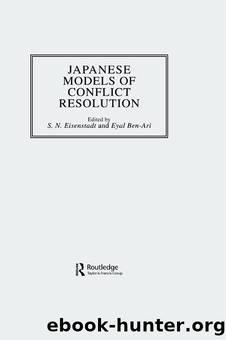Japanese Models Of Conflict Reso by Eisenstadt

Author:Eisenstadt [Eisenstadt]
Language: eng
Format: epub
ISBN: 9781138973657
Barnesnoble:
Publisher: Taylor & Francis
Published: 2016-09-02T00:00:00+00:00
Notes
1 Data on which the paper for this chapter is based was gathered in Japan while the author was supported by an Otsuki Peace Fellowship (1981â3). Thanks are due to Uri Almagor, S.N. Eisenstadt, Reuven Kahane and Adam Seligman for comments on an earlier version of the paper and to the Harry S. Truman Institute of the Hebrew University of Jerusalem and the Koret Foundation for aid in completing it.
2 This theoretical point is also made by Lebra (1984, p. 57). She has suggested that harmony and conflict in this society should not be seen as bipolarities, but rather as mutually related characteristics: the more harmony-oriented, the more conflict-sensitive. This is because, as the Japanese place more value:
upon social interdependence, cooperation, solidarity or harmony, than, say, the Americans, they are more likely to interfere with one anotherâs actions. The norm of harmony may be precisely what makes people more aware of conflicts with others, conflicts between their self-interest and obligations, and so forth. (Lebra, 1984, p. 56)
Thus, the harmony which one can find in many, but of course not all, sectors of Japanese society may best be understood as the outcome of constant efforts to avoid and manage very real conflicts within and between groups (Krauss et al., 1984b, p. 378). Thus, cultural values which emphasize harmony and the avoidance of conflict may actually intensify conflicts and therefore ârequireâ special efforts to handle them.
3 The formulation of the new ideology was facilitated by the activity of such ideologues as Uno Riemon. Reflecting a wide consensus around the aim of building a strong Japan in order to counter the threat of the West, he believed that âeducating workers to strive for the development of modern industry, with labor-management cooperation, took precedence over participation in a labor movement that produced domestic confrontations between labor and management.â (Hazama and Kaminski, 1979, p. 80). The concrete measures he urged for are interesting: periodic salary increases at fixed intervals, life-time employment, and retirement stipends.
4 Good overviews of the pre-war history of unionism in Japan can be found in Nishioka (1968, ch.3) and Gordon (1985).
5 Indeed, despite proclamations from national labour bodies to the contrary, since the end of the war, enterprise unions have not seriously sought to widen their numbers. Because permanent status is a precondition for union membership, and because life-time employment underlies this status, the very exclusion of temporary workers serves to symbolize the permanency of the unionists. This facilitates the definition of clear boundaries around permanent workers, leaving all outsiders literally âon their ownâ (Levine, 1967, pp. 260â1).
6 With few exceptions, national union organizations are federations of enterprise unions within specific industries (railways or textiles, for instance). Within these bodies, enterprise unions are highly autonomous: they make or change their own constitutions; control vital decisions; elect their own officials; initiate and stop industrial action (Japan Institute of Labor, 1979, p, 69; Levin, 1967, p. 267), decide independently on union dues; and are virtually autonomous in allocating funds to the national union (Shirai and Shimada, 1978, p.
Download
This site does not store any files on its server. We only index and link to content provided by other sites. Please contact the content providers to delete copyright contents if any and email us, we'll remove relevant links or contents immediately.
What's Done in Darkness by Kayla Perrin(26618)
The Fifty Shades Trilogy & Grey by E L James(19095)
Shot Through the Heart: DI Grace Fisher 2 by Isabelle Grey(19079)
Shot Through the Heart by Mercy Celeste(18953)
Wolf & Parchment: New Theory Spice & Wolf, Vol. 10 by Isuna Hasekura and Jyuu Ayakura(17132)
Python GUI Applications using PyQt5 : The hands-on guide to build apps with Python by Verdugo Leire(17022)
Peren F. Statistics for Business and Economics...Essential Formulas 3ed 2025 by Unknown(16895)
Wolf & Parchment: New Theory Spice & Wolf, Vol. 03 by Isuna Hasekura and Jyuu Ayakura & Jyuu Ayakura(16840)
Wolf & Parchment: New Theory Spice & Wolf, Vol. 01 by Isuna Hasekura and Jyuu Ayakura & Jyuu Ayakura(16468)
The Subtle Art of Not Giving a F*ck by Mark Manson(14384)
The 3rd Cycle of the Betrayed Series Collection: Extremely Controversial Historical Thrillers (Betrayed Series Boxed set) by McCray Carolyn(14158)
Stepbrother Stories 2 - 21 Taboo Story Collection (Brother Sister Stepbrother Stepsister Taboo Pseudo Incest Family Virgin Creampie Pregnant Forced Pregnancy Breeding) by Roxi Harding(13671)
Scorched Earth by Nick Kyme(12786)
Drei Generationen auf dem Jakobsweg by Stein Pia(10984)
Suna by Ziefle Pia(10902)
Scythe by Neal Shusterman(10366)
The Ultimate Python Exercise Book: 700 Practical Exercises for Beginners with Quiz Questions by Copy(10347)
D:\Jan\FTP\HOL\Work\Alien Breed - Tower Assault CD32 Alien Breed II - The Horror Continues Manual 1.jpg by PDFCreator(10302)
De Souza H. Master the Age of Artificial Intelligences. The Basic Guide...2024 by Unknown(10278)
